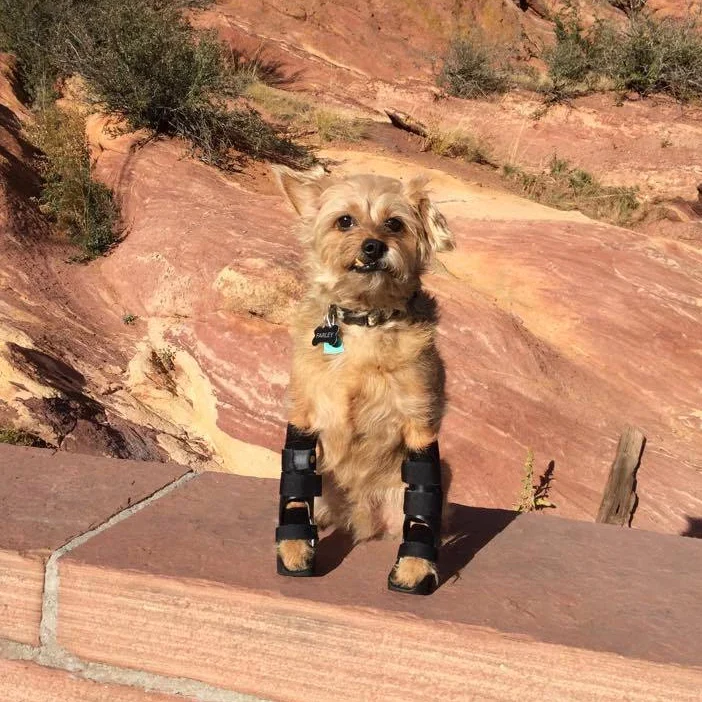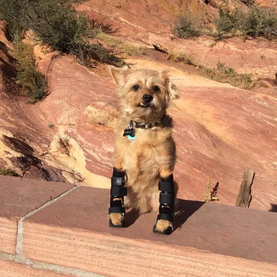01/12/2024
Carpal Hyperextension Injury and Current Treatments in Canines
Many dog heroes hyperextend their wrist or carpal joint leading to pain and lameness of the forelimb. When the carpus or wrist is hyperextended it, many times, damages the ligaments within the joint and it will not heal on its own. Compensations from this injury may lead to other injuries and/or underlying problems like a CrCL rupture or carpal hyperextension of the other front leg. Carpal hyperextension can happen from trauma when jumping down off of something or be a gradual process due to disease.
Standard Treatment: Surgical Carpal Arthrodesis
The standard of care that most veterinary surgeons outline is surgical carpal arthrodesis or fusion of the joint. This procedure requires the dog to go under anesthesia, the articular cartilage is burred away from the joint surfaces of the carpus, and then a plate and screws are placed across the joint with the ultimate goal of having the wrist bones grow together or fuse over an 8-12 week period. After surgery, dog heroes are then put in a rigid cast for that 8-12 week recovery process. Most clinics I have worked for change bandages every 2-4 weeks after being discharged from the hospital. The general consistency that I have experienced is that surgeons state that this is the best possible procedure for this type of injury.
Challenges and Failures in Surgical Approach
In a recent retrospective study that included 22 dogs, it was found that there was a 55% failure rate following surgical carpal arthrodesis, which means that for whatever reason the implants and screws needed to come out to cure the four-legged Hero from infection. Infection is partially due to prolonged bandage care over the 8-12 week recovery rate. It is in my opinion, from over 23 years of experience within the field, that if infection is present within the carpal joint then the growth of the carpal bones slows and/or doesn’t heal to be able to support the patient’s weight. This is essentially a failed surgery. Infection cannot be cured if there are implants present. Implants are made of surgical stainless steel and they have no blood supply. This means they harbor the bacteria and regardless of what kind or how long the patient is on antibiotics infection will prevail. In my 23 years of experience seeing these types of patients I can contest that I saw more failure than success, post-operatively. I can think of many patients who even came in years after surgery with low-grade infections, causing lameness and pain, where their surgical implant needed to be removed. When implants need to be removed due to infection, then the infection can be cured, but this also yields a joint that never really fuses together, and the Hero patient goes through months, if not years, of wax and waning pain and lack of somewhat normal function. Pet parents are generally confused, frustrated, and sometimes angry with these results. Many surgeons will blame the owners for poor aftercare of bandages, as strict, almost impossible aftercare instructions are outlined at discharge from the clinic. This problem is not new, it’s been going on for 30-40 years with no real options for alternative treatments. I have worked for surgeons who, behind closed doors, say that they would rather never see patients with carpal hyperextending injuries as described above but they offer them anyway.
Alternative Treatment: Custom Bracing
Other treatments may include but are not limited to custom bracing after surgical arthrodesis or as an alternative treatment. A custom brace could be fabricated within a 2-3 week period. This would involve making a mold or cast of the limb and sending it to a veterinary brace manufactory company. Carpal braces are one of the easiest braces to fabricate with a simple AFO design from the human orthotic world. This design allows for weight to be evenly distributed over the anterior and posterior surfaces of the dog’s metacarpals and the radius/ulna. Tamarack joints can also be easily placed to help the dog hero reduce compensations within the swing phase of gait. This leads to more normalized movement and ultimately less pain and better function long term. The cost of custom braces can range from $900-1200 per brace.

Considerations and Challenges with Braces
Braces are not a fix-all. They can also hold problems that may not be foreseen before fitting a Hero dog with one. Some dogs may start to have flexor tendon contracture. When this happens the animal’s foot can sometimes be hard, if not impossible, to place flat-footed within the brace. When this occurs we recommend a new brace design that allows the dog to be comfortable but they may not be able to fully extend their toes. A new design may cost the same amount as the first brace placed. Still, given the current cost of surgical carpal arthrodesis, it would only be 10-20% of the surgery cost, antibiotics, bandage changes, cultures, physical rehabilitation, and the pain and stress that the dog and owner go through during surgical arthrodesis recovery. High and low estimates across the United States of the cost of carpal arthrodesis was $4000-5000 just for surgery. Culture and sensitivity tests can cost upwards of $300-400 and if there is a resistant infection grown in the lab, then antibiotics could cost hundreds, if not thousands of dollars, for just a week or two. Most veterinarians will do 21-day courses of antibiotic therapy. Implant removal is also an additional cost for pet parents. These can run $2000-4000 dollars depending on the clinic and where it is within the country.
Potential Issues with Braces
Other problems that may occur with braces are rub sores. Rub sores can also cause infection, and other problems but if implants were never put in or have been taken out it is likely that they can be cured fairly easily with conventional antibiotic therapy.
Braces can be cumbersome to take on and off, they can show signs of wear, just like shoes for people, and these problems should be considered when deciding what’s best for your patient or pet.
Understanding Pain in Dogs
It’s likely important for pet parents of Hero dogs to know that if your dog is limping, it is more than likely, that they are in pain. Only a veterinarian can truly diagnose pain in a dog, but that doesn’t mean we should ignore the symptoms. The stability of the joint may and can reduce pain and allow the pet dog to function at near-normal activity levels. Hero custom braces can replace the old-school medicine described in this blog with great success.


